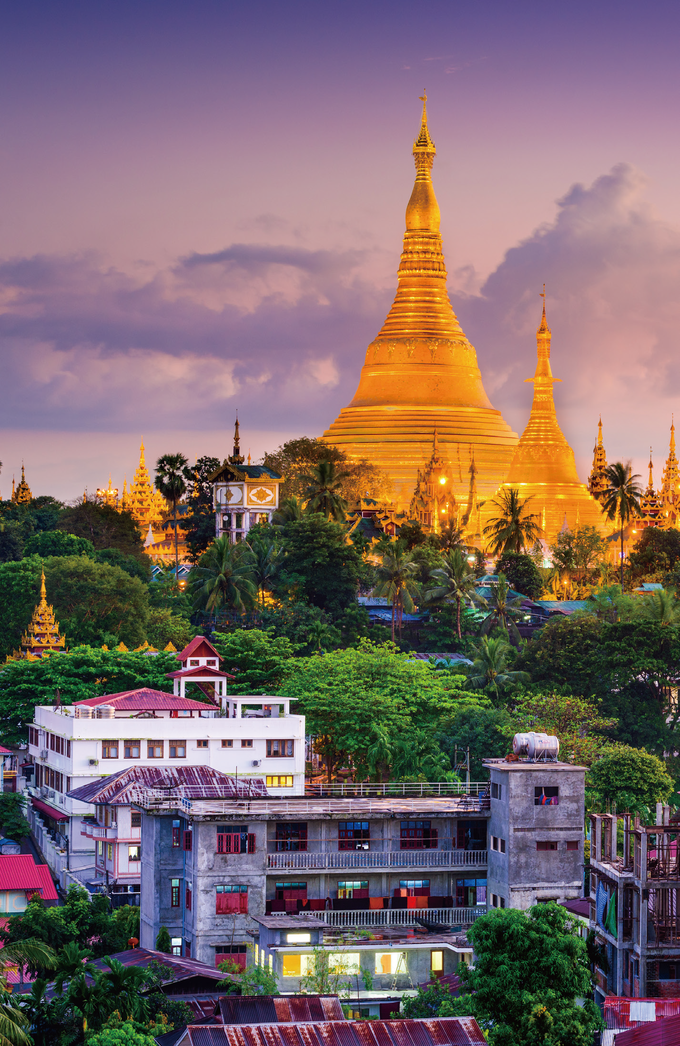
나는 최근 대형 부동산 개발사의 초대를 받아 미얀마에서 시간을 보냈다. 미얀마, 혹은 버마Burma(동남아시아 미얀마의 구칭)는 이전부터 알려진 것처럼 세계 2차 대전 이후 동남아시아에서 가장 부유한 나라였다. 그리곤 미얀마는 자립적 사회주의 형태의 군사독재로 근 60년간의 침체기에 접어들었다. 하지만 경제 자유화와 민주화로 인해 2008년부터 빠른 경제적 성장을 보이고 있다.
오늘날의 미얀마는 눈에 띄는 성장으로 아시아 지역에서 마지막 시장 개척지로 급부상 하고 있다. 매년 6%씩 성장하고 있는 실질 GDP는 이후 5년간 연 8%로 성장세를 가속화할 것으로 예상한다. 미얀마의 중산층 소비자 수도 2020까지 두 배로 늘어날 전망이다. 게다가 가스, 오일, 보석Gems, 아연Zinc과 구리Copper등의 천혜자원도 풍부해 미얀마의 시장성은 매우 뛰어나다고 볼 수 있다.
특히 미얀마는 30대의 중년층 5300만 인구의 시장이 크다. 도시화 비율은 34%로 베트남과 비슷하지만 국내총생산이 1400달러로 빠르게 성장하고 있다. 또한 외식분야의 시장성은 13억으로 태국이 200억, 베트남이 350억인데 비하면 아직 적은 수치지만 매년 적어도 10%씩의 성장세를 보이고 있다. 미얀마의 가계 지출은 식재 38%와 교육비 12%, 그리고 외식 가계지출은 전체 지출의 5% 정도다.
 다음은 필자가 생각하는 미얀마 외식시장의 동향이다.
다음은 필자가 생각하는 미얀마 외식시장의 동향이다.
▶ 미얀마에서 레스토랑과 호텔체인 사업은 제1, 2 도시 모두에서 큰 가능성을 보이고 있다. 개발사들은 빠르게 양곤에 투자하고 있지만 제2의 도시에도 아파트와 회사, 쇼핑몰 등의 개발에 빠르게 눈을 돌리고 있다.
▶ 그래도 메인 시장은 양곤이다. 양곤에 몇 없는 쇼핑센터가 자리 잡고 있었지만, 최근에 들어서고 있는 센터들은 어느 동아시아의 센터보다 우수한 퀄리티를 자랑한다. 개발사들은 양곤의 지리적 특성을 빠르게 이해하고 있으며, 운영을 서포트 할 세계적 부동산 인재들을 대거 고용하고 있다. 물론 회사들의 대부분은 가족경영회사다.
▶ 외식시장은 더 빠르게 변화하고 있다. KFC는 지난 2015년에 첫 매장을 오픈했는데, 2년이 지난 2017년 말까지는 총 22개의 매장을 운영할 예정이다.
▶ 미국, 일본, 한국 그리고 다른 동남아시아 지역의 많은 브랜드들이 미얀마 시장에 들어오기 위해 공격적인 파트너십을 맺고 있다.
▶ 롯데리아의 경우, 이미 미얀마에서 합작투자를 진행하고 있으며 베트남에서 그러했듯 QSR 버거 시장을 선점하기 위해 노력 중이다.
▶ KFC, 롯데리아, 피자헛, Pizza Company, BreadTalk 그리고 Swensen’s Ice Cream과 같은 메인 브랜드들은 주말에 매장을 찾는 손님들로 문전성시를 이룬다.
▶ 내가 양곤을 다녀와 본 견해로는 QSR과 다소 저렴한 개념의 Full Service Restaurant를 즐길 수 있는 중산층 시장이 명백히 성장하고 있는 듯 보였다.
▶ 상업 부동산의 부족으로 인해 매장 개발은 아직까지 제한이 있어 보이지만 빠르게 변화하고 있다. 게다가 몰의 경우에는 초대형 슈퍼마켓도 들어설 예정이다. 거리 상권에 대한 투자도 가능해보이지만 개별 임대주와 거래할 경우에는 법적 위험부담이 크다.
▶ 미얀마 사람들은 경제가 성장하고 정책이 안정화되면서 더 잘 먹고 행복한 것으로 나타났다.
▶ 버거보다는 치킨을 베이스로 둔 콘셉트가 시장성이 있어 보인다. 공급사슬은 롯데리아나 졸리비보다 높은 퀄리티를 지향하는 고기 메뉴의 맥도날드나 버거킹에 초점을 둔다.
▶ 대부분의 아시안 마켓에서 그랬듯 일식이 현지식 다음으로 가장 인기 있다.
▶ 최근에 베트남에서 좋은 예를 보여준 것처럼 한식도 좋은 기회를 선점할 수 있을 듯 보인다.
미얀마 시장에 진출하기 위한 준비는 지금이 적기인 듯 보인다. 조금이라도 지체한다면 좋은 파트너를 찾기 힘들 것이다. 지역적 위험요소를 고려해볼 때 마스터 프랜차이즈 모델은 대부분의 세계브랜드를 더 선호하겠지만, 프랜차이저들은 미얀마의 원재료 시장과 상표등록확인 등 공급체인의 상황에 대한 주의 깊은 이해가 필요하다.
아시아에 남아있는 유일한 기회! 개발의 여지가 많은 미얀마가 바로 그곳이다!
MYANMAR – THE FINAL FRONTIER
I recently spent time in Myanmar at the invitation of a large commercial real estate developer. Myanmar or Burma as it was previously known, was the richest country in Southeast Asia after WWII. The county was frozen in time for over 60 years due to long term military dictatorships practicing a form of self- reliant socialism. Since 2008, economic liberalization and democratization have led to strong economic growth. Myanmar today is the last economic frontier in Asia with significant growth opportunities. Real GDP has recently been averaging more than 6% per annum and is expected to accelerate to over 8% in the next 5 years. The number of middle class consumers is expected to double by 2020.The country is also rich in natural resources such as gas, oil, gems, zinc and copper.
Myanmar is a large market of 53 million people with a median age of only 30 years. The urbanization rate is only 34%, approximately equal to Vietnam and GDP per capita is $1400 but growing rapidly. We estimate the consumer food service market is only $1.3 Billion compared to $20 Billion for Thailand and $35 Billion for Vietnam, but it is growing at least by 10% per annum. Dining out accounts for only 5% of household expenditure currently with 38% spent on groceries and 12% on education respectively.
Here are my thoughts after spending time in the market.
∙ There is a very a large opportunity for restaurant and hotel chains in both Tier 1 and Tier 2 cities. Commercial developers are quickly building out Yangon but looking to move rapidly into secondary cities for apartments, office buildings and malls.
∙ The main action currently is in Yangon. There are a limited number of international standard shopping centers but the newer ones are as good as any in Southeast Asia. Commercial developers are learning quickly and hiring overseas rea estate talent to support local management. Of course, the majority of these companies are family owned businesses.
∙ The food service market is changing very quickly. KFC opened their first store in 2015 but expects to have 22 operating locations by the end of 2017.
∙ Many brands from the USA, Japan, Korea and other Southeast Asian countries are quickly establishing partnerships to enter the market.
∙ Lotteria is already here with a joint venture and looks to dominate the QSR burger market as they do in Vietnam.
∙ Major brands such as KFC, Lotteria, Pizza Hut, Pizza Company, BreadTalk and Swensen’s Ice Cream are very busy on weekends.
From my walks around Yangon it is clear that there is a growing middle class that can afford QSR and cheaper forms of full service restaurants.
∙ Store development is still restricted by the lack of sufficient commercial real estate but this is changing rapidly. In addition to malls, hyper marts are also seeing investment. Street locations are available but there are many legal risks when dealing directly with individual landlords.
∙ The Burmese people look well fed and happy to finally have economic growth and political stability.
∙ Concepts which are chicken based will do better than burgers. The supply chain is a major challenge for meat focused chains like McDonald’s and Burger King which tend to have higher quality standards than Lotteria or Jollibee.
∙ As is common to most Asian markets, Japanese food is the most popular after local cuisine.
∙ There is good opportunity for Korean food as well given the recent example of Vietnam.
The time is right to enter Myanmar now and start preparations. Those who delay may find that it is difficult to find good partners. Given the country risk, a master franchise model will be preferred by most overseas concepts but franchisers should carefully study the supply chain situation for their key raw materials and confirm their trademark registrations before entering into negotiations with potential partners. There is only one greenfield opportunity left in Asia and Myanmar is it!

Joel Silverstein
이스트웨스트 호스피탤리티 그룹 대표
현재 홍콩에 거주하며 최고 경영진과 포춘 Fortune 500대 기업이 다수 아시아 국가에서 지속 가능한 성장을 할 수 있게 도와주고 있다.
- -2025.04.03(목)~2025.05.07(수) 투어리즘&마이스 데이터로 만드는 스마트한 여행, 관광데이터 활용 공모전 진행
- 2025.03.26(수)~2025.04.15(화) 대회·공모전 한국관광공사,‘관광기업 데이터 마케팅 컨설팅 지원 사업’공모
- - 2025.02.24(월)~2025.03.14(금) 대회·공모전 한국관광공사, ‘관광기업 혁신바우처 지원사업’ 공모
- 2025.01.20(월)~2025.02.14(금) 대회·공모전 지역여행 혜택 제공 서비스 ‘디지털 관광주민증’ 사업 지자체 공모
- 2024.11.05(화)~2024.11.11(월) 대회·공모전 서울특별시관광협회, 제27대 협회장 후보자 등록 실시
- [Joel의 Global Dining Market] 로보틱스, 자동화의 시대가 도래하다 2021-06-15
- [Joel의 Global Dining Market] 가상공간의 외식 브랜드 시장 속에 실재할 수 있을까? 2021-04-05
- [Joel의 Global Dining Market] 뉴노멀에 적응하는 식당가들의 새로운 전략_ 배달음식 전문점 2020-11-12
- [Joel의 Global Dining Market] 해외 진출의 관문? 홍콩 시장의 인기_ 외식업계 위기와 변화 면밀히 살펴봐야 2020-09-20
- [Joel의 Global Dining Market] 코로나19의 여파, 미국 외식 산업의 위기_ 더 좋은 음식과 더 나은 서비스로 고객 공략해야 2020-08-03
- [Joel의 Global Dining Market] 코로나19로 기세 오른 플랫폼 비즈니스_ 레스토랑과 상생하는 모델 모색해야 2020-06-02
- [Joel의 Global Dining Market] 아픈 손가락의 성장 필리핀 2020-04-20
-

힐튼, ‘월도프 아스토리아 오사카’ 오픈으로 일본 럭셔리 호텔 시장의 새 시대 열어
- 2025-04-03
- 서현진 기자
-

대구 메리어트 호텔, 5성급 호텔 재인증
- 2025-04-03
- 서현진 기자
-

[Hotel IT] ㈜티오더스테이, (사)명동상인협의회 - 호텔스카이파크 그룹과 MOU 체결
- 2025-04-03
- 서현진 기자
-

몸과 마음 모두 '리셋'... 반얀트리, 둘만의 웰빙 여행 '커넥션' 프로그램 론칭
- 2025-04-03
- 안수진 기자
-

민텔, 2025 '플레이버 트렌드' 발표… 2025년 핵심 맛 트렌드는?
- 2025-04-03
- 안수진 기자
-

데이터로 만드는 스마트한 여행, 관광데이터 활용 공모전 진행
- 2025-04-03
- 서현진 기자





























